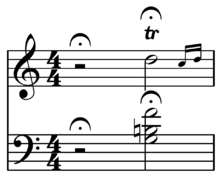
Back Calderó Catalan Koruna (hudba) Czech Fermat (musik) Danish Fermate German Κορώνα (μουσική) Greek Fermato Esperanto Calderón (música) Spanish Fermaat Estonian Kalderoi (musika) Basque فرماتا Persian



A fermata (Italian: [ferˈmaːta]; "from fermare, to stay, or stop";[2] also known as a hold, pause, colloquially a birdseye or cyclops eye, or as a grand pause when placed on a note or a rest) is a symbol of musical notation indicating that the note should be prolonged beyond the normal duration its note value would indicate.[3] Exactly how much longer it is held is up to the discretion of the performer or conductor, but twice as long is common. It is usually printed above but can be occasionally below (when it is upside down) the note to be extended.
When a fermata is placed over a bar or double-bar, it is used to indicate the end of a phrase or section of a work. In a concerto, it indicates the point at which the soloist is to play a cadenza.[4]
A fermata can occur at the end of a piece (or movement) or in the middle of a piece. It can be followed by either a brief rest or more notes.[5]
Fermata is the Italian name for the sign (𝄐), which in English is commonly called a Pause, and signifies that the note over which it is placed should be held on beyond its natural duration. It is sometimes put over a bar or double bar, in which case it intimates a short interval of silence.[6]
Other names for a fermata are corona (Italian), point d'orgue (French), Fermate (German), calderón (Spanish), suspensão (Portuguese).[3]
- ^ Sir George Grove (1904). Grove's Dictionary of Music and Musicians, Vol. 1, p.442. John Alexander Fuller-Maitland, ed. Macmillan Company.
- ^ Stainer, John and Barrett, William Alexander (1898). Stainer and Barrett's Dictionary of Musical Terms, p.169. Novello. [ISBN unspecified].
- ^ a b The Harvard Dictionary of Music, p. 310
- ^ The Oxford Dictionary of Music, p. 293
- ^ McElheran, Conducting Technique, Chapter XVII, "Fermatas", p. 85. The author classifies them into three types: fermatas followed by uninterrrupted sound, fermatas followed "by a short period of silence," and fermatas "followed by a long period of silence." After that classification, the author gives detailed advice for conducting each type.
- ^ Grove, et al.; eds. (1906). Grove's dictionary of music and musicians, p.21. Macmillan. [ISBN unspecified].
© MMXXIII Rich X Search. We shall prevail. All rights reserved. Rich X Search
